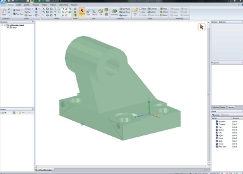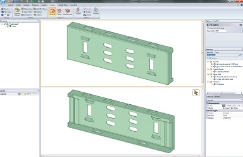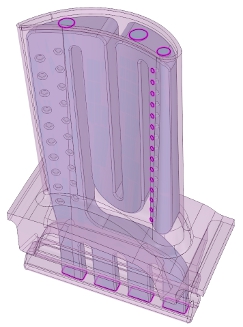SpaceClaim is an interesting beast of a 3D design system. Its launch in 2007 was the catalyst for many CAD software developers to concentrate on the direct editing of geometry, which has now become a major focus for the 3D design tool industry.

SpaceClaim 2011’s assembly performance improvements were driven by customers in automotive, aerospace, and defence industries.Users can now import assemblies as lightweight models, caching the translated precise geometry to disk to save memory. Also, users can now unload reference parts on-the-fly to boost performance
During the past four years we’ve seen SpaceClaim change from being a basic and general-purpose tool designed to manipulate ‘dumb’ geometry into something more intriguing.
As a newcomer to the market, SpaceClaim naturally found it hard to compete on a feature by feature matching of the likes of SolidWorks, Inventor, Solid Edge et al. Instead, the team took a different approach, and looked to bring its robust set of modelling tools to a more niche group of users – those that need access to 3D modelling but don’t necessarily want the steep learning curve. To help drive this forward SpaceClaim signed a number of partnerships.
The deal with Ansys, which saw SpaceClaim technology become a part of the simulation giant’s offering for model preparation by simulation experts, as opposed to design experts, is one. Another is the deal with machine tool manufacturer, Trumpf, which saw SpaceClaim’s tools for sheet metal design and manipulation expand.
SpaceClaim has also found a home with many organisations that need a system that allows them to read in data in a wide range of formats, repair them and re-purpose them for use other systems.
Taking all this into account, the 2011 release looks to extend many of these sweet spots further.
Modelling updates
In terms of modelling updates, there are improvements made to the surface modelling functionality – in specifics, the control available when creating lofted forms.
There’s a new hand drawn curve command that is useful for making a quick sketch (though more analytic type methods will still remain the default for quality curves). There’s also a new symmetric move operation that automatically detects symmetric geometry and moves it accordingly.
Symmetry also pops up in enhancements to the assembly modelling, with improvements made to the assembly conditions that now include the ability to mirror components. There is still no control over the mirroring of sub-assemblies and handing components though.
The final general modelling update is when working with assemblies. Components can now be made ‘lightweight’, which will be particularly useful for those working with large complex products or when running the system on lower-powered hardware.
In relation to the core modelling updates, SpaceClaim 2011 can now interact with mesh-based forms from STL files. Essentially it introduces tools for snapping to these tessellated forms.
This allows a mesh to be imported and then SpaceClaim’s modelling tools used to quickly create an analytic version of the part which is much more accurate.
The practical uses for this new capability are wide ranging, but I can imagine bringing in imported data from a reverse engineering workflow, using SpaceClaim to snap geometry to the mesh and creating a new part that can be adapted.
Sheet metal
The partnership with Trumpf last year gave SpaceClaim’s sheet metal capabilities a shot of adrenalin.
The 2010 release saw the introduction of a range of new tools for the creation of sheet metal forms and the addition of a library of punches or forms. 2011 continues this work but concentrates on working with imported data and the creation of intelligent sheet metal components.
Tools are now available to: remove rounded corners or fillets, detect bends, unfold parts, and recognise sheet metal type features. The recognition works in both an automated mode, which is most useful for finding bends and positions for rips, and a manual process for finding features such as hems, jogs, beads, and punches. It then supports the creation of the flatted part. The benefit of this new process is clear.
Whereas, traditionally, a lot of manual rework would be required to build a model from scratch, a dumb part can now be made intelligent again. This allows the manufacturing engineer to experiment with the values for rip, bend, and weld configurations to reduce manufacturing or material costs.
This would not have been possible with a drawing or a dumb 3D model. Model preparation The preparation of models for downstream purposes has been something SpaceClaim has focussed on since the very beginning.
The examples are numerous: removing blends and chamfers, small holes or other inconsequential features from models for use in Finite Element Analysis (FEA), or creating internal volumes for Computational Fluid Dynamics (CFD) applications.
For SpaceClaim 2011 there has been a the bi-directional associativity that allows parametric values to be passed between the two systems, creating a pretty effective environment for optimisation.
There are also new tools to assist with the extraction of face and edge loops automatically when creating internal flow volumes for CFD purposes.
The general updates
There are a couple of updates that are applicable across the board, so it’s worth grouping these into one section.
SpaceClaim has offered integration with the TraceParts content library for some time, providing users with access to millions of standard and manufacturer parts. Originally stored on the local hard drive, this has now been switched to an online service. This helps ensure the library is always up-to-date.
Another general update is that floating licenses can be borrowed for offline use. This is something that more vendors need to introduce.
Today’s designers and engineers are often multi-tasked with sales, support and client relations and that rarely means sitting in the office all day.
Conclusion
This isn’t a massive release for SpaceClaim in terms of brand new functionality and headline grabbing features. Instead, the work done demonstrates that the system is finding its niche and exploring potential for new niches.
A case in point are the enhancements to sheet metal, particularly in light of the partnership with Trumpf. After all, most manufacturing engineers working with Trumpf’s machine tools are not likely to
have access to the native CAD software that creates the parts they’re sent.
They need to be able to take the geometry, repurpose it for manufacturing and, in many cases, make adjustments. Designers and engineers might not like to hear that, but it has to happen to achieve the form and function required.
The on-going work with Ansys is also fascinating. The simulation giant has always had some form of modelling tools within its product portfolio, but they’ve always appeared to be something of an afterthought. The bi-directionality between SpaceClaim and Workbench is something I’d love to see expanded upon and I can see it finding a place in the toolkit of many Ansys customers.
SpaceClaim is an interesting system to watch mature and it’s clear that it is finding its feet and exploring new avenues of potential. The partnerships with Trumpf and Ansys show that a clean, efficient modelling system is still required by many different types of users, rather than the often bloated and overweight mainstream offerings.
There are many potential users out there that might consider themselves to be outside of the core community for 3D design, but may find that SpaceClaim does just enough to get them the results they require.
This isn’t necessarily about price either. There are many very low cost product offerings out there but these can be clunky in nature and functionally restricted. SpaceClaim is relatively lower cost compared to many mainstream players but is also clean, efficient and unencumbered by decades of development.
www.spaceclaim.com
| Product | SpaceClaim Engineer 2011 |
|---|---|
| Company name | SpaceClaim |
| Price | from $2,445 |









